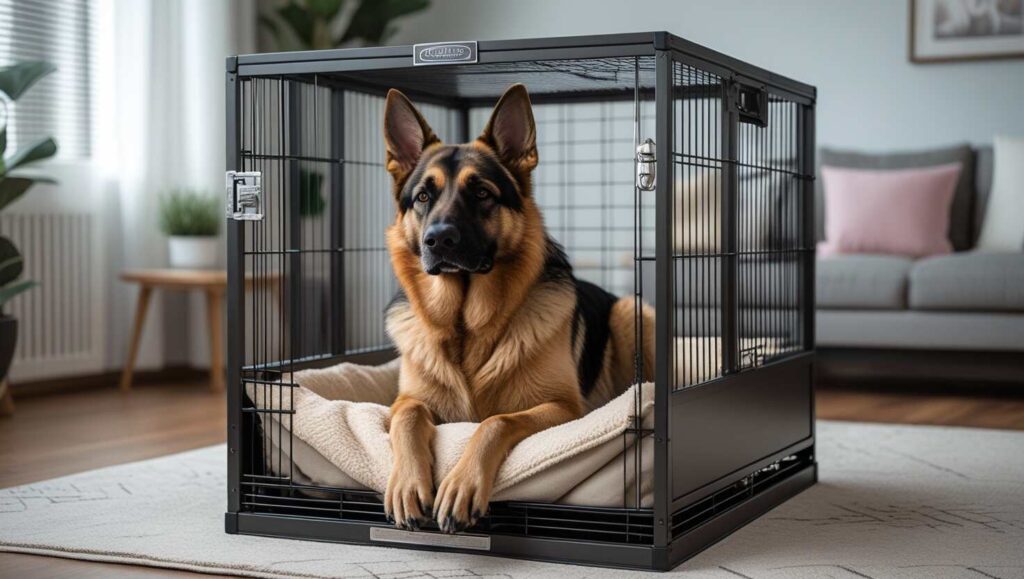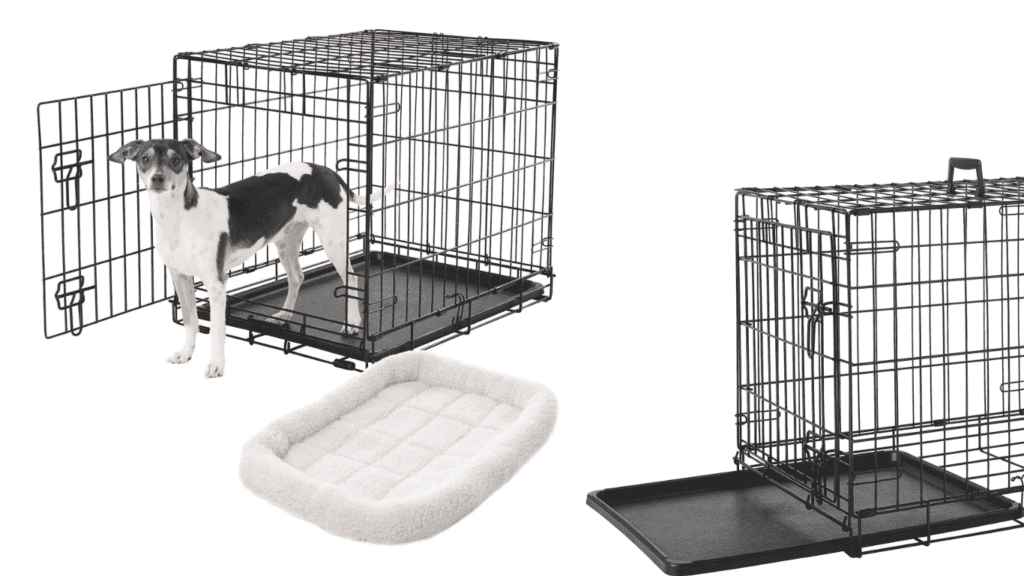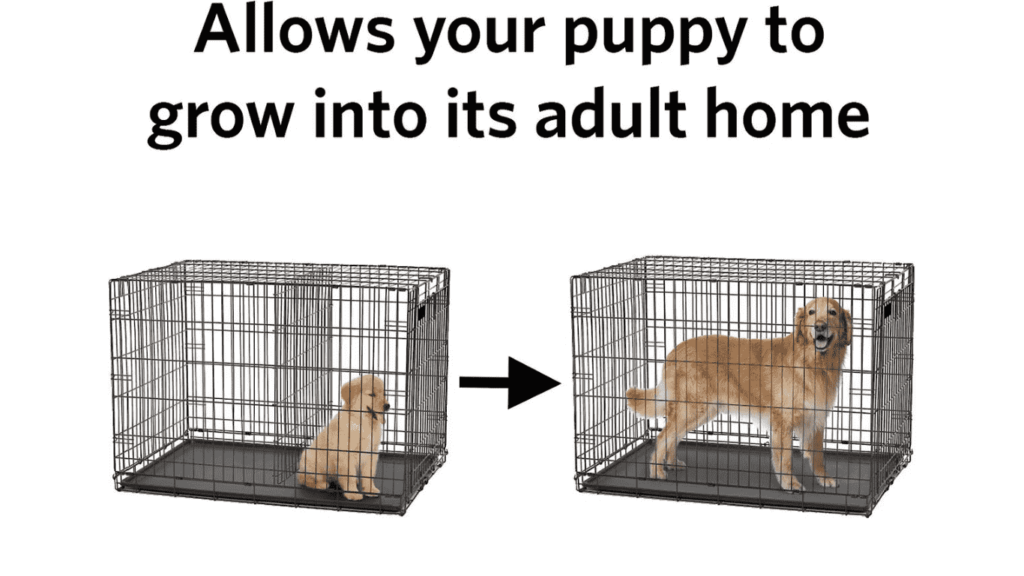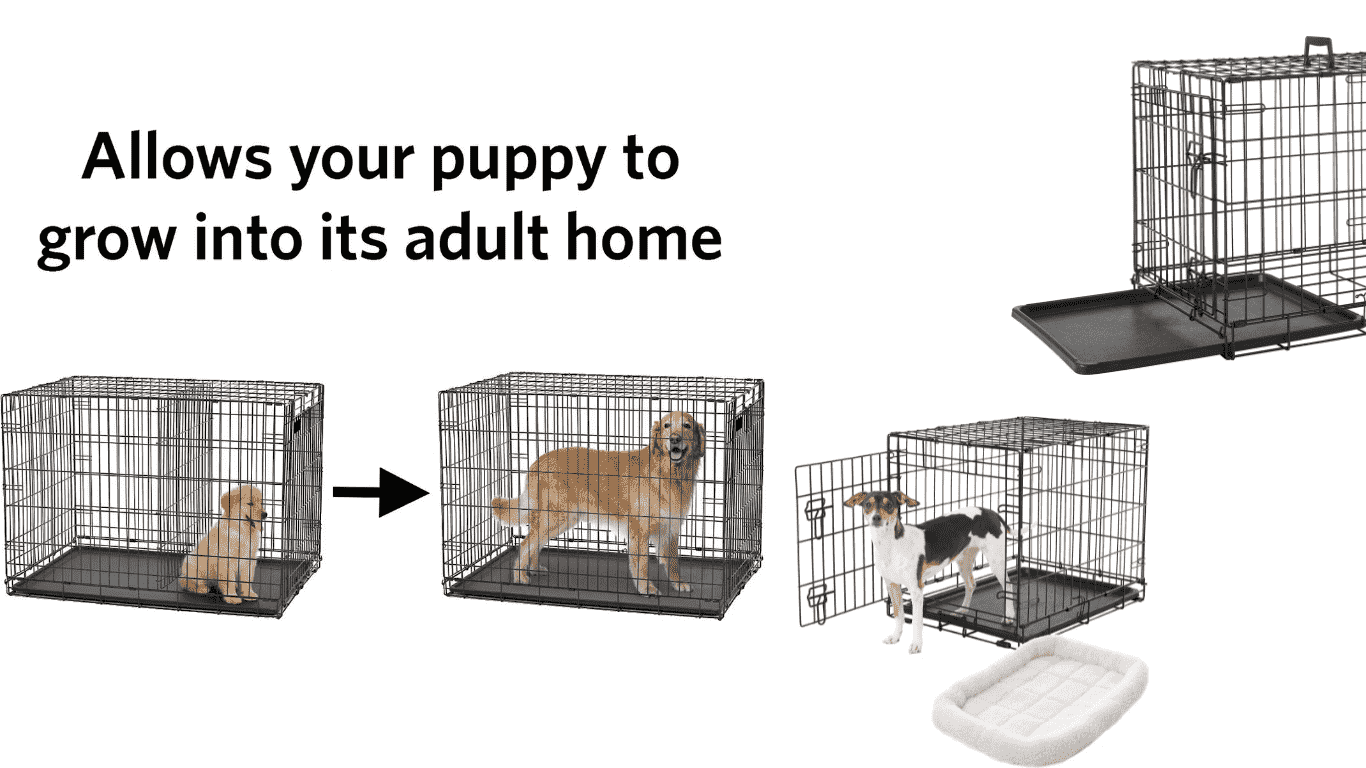What Size Dog Cage for a German Shepherd?

For a German Shepherd, a 48-inch crate (48″ x 30″ x 33″) is ideal, offering enough space to stand, stretch, and lie down comfortably. Proper sizing supports training, safety, and overall well-being. Adjustable crates with dividers are great for growing puppies. Durable materials and secure features ensure comfort and longevity.
Understanding
Choosing the right size dog crate for a German Shepherd can make all the difference for both comfort and crate training success. As a pet owner who has worked with this dog breed, I know how crucial it is to provide a safe space where your GSD can stand up, turn around, and lie down comfortably. An appropriately sized crate helps avoid negative feelings and supports house-training without causing accidents.
For an adult GSD, the suitable size typically measures 48 inches in length, 30 inches in width, and 33 inches in height. This gives them ample room to stretch out, sit, or lie on their side with their limbs fully extended. Make sure there’s at least 2 inches of clearance above their head so they can move with ease.
Avoid going for a too-large crate, as it can feel less secure and hinder crate training. If you’re unsure, measure your pet and consider the next size up only if your dog seems too tight in the recommended dimensions. A well-fitted dog crate offers the perfect balance—enough space without overwhelming your medium to large-sized furry friend.
Why Cage Size Matters for German Shepherds
The Importance of Proper Space
Choosing the right crate for your German Shepherd is as important as insurance for a newly bought car—the wrong fit can turn your dog’s life and your house upside down, making things a living hell instead of easier.
Benefits of Using the Right Cage Size
SECURITY AND SAFETY: A crate offers the safest and most secure space for your GSD, providing extra safety when unsupervised. It’s essential for keeping your dog protected and comfortable.
HOUSE TRAINING AID: An effective tool for potty training, teaching dogs to avoid soiling their sleeping area by managing their bladder and bowels until they can go outside.
TRAVEL CONVENIENCE: A crate makes transportation easier and safer, reducing stress whether your dog stays home or becomes your travel companion.
PREVENTING DESTRUCTIVE BEHAVIOR: Helps limit access to certain areas, preventing your GSD from developing destructive habits when left unsupervised.
STRESS MANAGEMENT: Offers a private space for your dog to retreat and relax during thunderstorms, fireworks, or when there are guests.
FACILITATING TRAINING: Essential for crate training and obedience training, teaching your dog to follow commands and avoid disobeying.
VETERINARY VISITS AND RECOVERY: Provides a controlled environment for rest and healing after surgery or during recovery periods, ensuring your dog heals properly.
Common Mistakes When Choosing a Dog Cage
RESTRICTED MOVEMENT: Choosing a small cage can confine your GSD, limiting their ability to stretch or change positions comfortably, which affects their overall well-being.
SOCIAL ISOLATION: Leaving your dog in a crate for excessive time can lead to feelings of loneliness, increasing the risk of separation anxiety and negatively impacting their mental well-being.
LACK OF MENTAL STIMULATION: Without proper engagement, your GSD may become bored, leading to destructive behaviors such as excessive chewing, barking, or digging.
POTENTIAL PHYSICAL DISCOMFORT: Small dog cages can restrict movements, preventing your dog from stretching or shifting positions, which may cause discomfort or health issues.
TRAINING CHALLENGES: Relying solely on crate training can create obstacles, as it should never substitute proper training and socialization for your GSD.
Recommended Dog Cage Size for German Shepherds
Average Size of a German Shepherd
To measure your dog’s size accurately, check the length from the tip of the nose to the base of the tail and the height from the ground to the top of the head. These measurements help you decide the best crate measurements to comfortably house your pup.
Ideal Cage Dimensions
The ideal crate size depends on your dog’s weight and height. A 36″ crate with typical dimensions of 36″ x 23″ x 25″ is advisable for dogs weighing 40 to 70 pounds.
For larger breeds, like German Shepherds, a 42″ crate measuring 42″ x 28″ x 31″ fits dogs between 70 to 90 pounds. If your dog weighs over 90 pounds, a 48″ crate (48″ x 30″ x 33″) is the most suitable.
A medium crate (30″ x 20″ x 22″ LWH) works for dogs under 22″ in height, like a Beagle or Border Collie. Larger breeds such as Golden Retrievers or German Shepherds need a large crate (36″ x 24″ x 27″) for proper comfort.
For extra-large breeds, like Mastiffs or Cane Corsos, a 42″ x 28″ x 32″ crate is ideal. Always consult a veterinarian or trainer for size variations and your dog’s unique needs.
Sizing for Puppies vs. Adults
How to Accurately Measure Your Puppy
To find the best crate size for your German Shepherd puppy, you need to measure their body accurately. Start by measuring the length from the tip of their nose to the base of their tail. This helps determine how much space they need to lie down comfortably. Next, measure their height from the ground to the top of their head or shoulders—whichever is taller. These measurements help you estimate the proper crate length and ensure your pup will have enough room to stretch and move around without feeling restricted.
Considering Your German Shepherd’s Adult Size
Since German Shepherds (GSDs) grow fast, it’s important to consider their adult size when selecting a crate. On average, an adult German Shepherd stands about 22-25 inches tall at the shoulders and can weigh anywhere between 50 to 90 pounds. When buying a crate, you should think about their projected adult size to avoid frequent upgrades. A good rule of thumb is to choose a crate that is 1.5 times larger than your puppy’s current size, ensuring they have enough space as they grow. This provides ample room for them to stand, stretch, and turn around easily, even as they mature.
Choosing the Right Crate Size
For a growing GSD puppy, choosing the correct size can be tricky. Starting with a small size crate may seem appropriate for a young pup, but as they grow quickly, this will need to be replaced soon. A large crate gives your puppy space to move around, but going too big can create potty-training challenges. If the crate is too large, your puppy might use one corner as a bathroom, which can delay training progress and encourage control problems. The crate should be big enough for your puppy to stand up, lie down, and turn around comfortably without having too much extra space.
Using Adjustable Crates for Growing German Shepherds
An adjustable crate with a crate divider is an ideal solution for a growing GSD. You can start with a larger crate and use panels to block off extra space, making it more suitable for your puppy’s current size. As your dog grows, you can gradually move the removable divider back to create more space. This prevents the need for buying multiple crates and ensures your puppy always has an appropriately sized and secure environment. This method also helps maintain effective potty training by keeping the space limited enough to encourage good habits.
Crate Sizes for Different Stages
For a German Shepherd puppy, a 36″ crate (36″ x 23″ x 25″) is generally suitable when they are younger and weigh around 40-70 pounds. As your dog grows, transitioning to a 42″ crate (42″ x 28″ x 31″) is advisable for dogs weighing 70-90 pounds. For adult German Shepherds over 90 pounds, a 48″ crate (48″ x 30″ x 33″) will provide enough space for them to move around and rest comfortably. This size offers enough room for your GSD to stretch, lie down fully, and stand without feeling cramped.
Addressing Growth Challenges and Comfort
A major downside of starting with a smaller crate is that German Shepherd puppies can outgrow it very quickly. Investing in a larger, adjustable crate prevents the hassle of frequent upgrades. Additionally, to make your dog’s space more comfortable, add soft bedding or pillows without taking up too much space. As your puppy grows, be mindful to block off extra room using dividers until they mature.
Supporting Training and Well-being
Having a crate that’s the right size offers several benefits. It supports potty training by encouraging your GSD puppy to avoid using their sleeping area as a bathroom. A space that’s too big can lead to mistakes and make it harder for your puppy to develop good bathroom habits. A well-fitted crate helps reinforce natural instincts to keep their sleeping space clean, making training easier and more effective.
Material, Durability, and Comfort
When buying a crate, look for durable materials that are also easy-to-clean. Younger dogs often have teething needs, so a crate made from coated steel wire is a good choice—it’s durable, resists chewing, and offers proper ventilation so your dog can see out easily. For extra comfort, consider using a crate cover to create a more secure and calming space. You can always remove the cover as your puppy becomes more comfortable and confident in their new environment.
Features to Look for in a Dog Cage
Material and Build Quality
When selecting a crate for on-the-go use, ensure it offers a closer fit with less excess space to keep your dog safer during travel. Before buying, measure the length, width, and height of your cargo space or truck bed to ensure a proper fit.
If you’re flying with your pup, follow airline directions and check size requirements. A well-fitted crate helps prevent accidents and keeps your dog secure. When in doubt, ask questions to ensure the crate suits both your dog and travel needs.
Safety Features
For German Shepherds and other large dogs, choosing the right crate size is crucial. It should offer enough space for your GSD to stand, turn around, and lie down comfortably. A crate made from sturdy materials like aluminum or metal ensures durability and resists potential chewing.
Wire crates or strong plastic crates offer great ventilation with bars or mesh panels for adequate airflow, preventing overheating. Look for safety features like secure latches and locks to keep your dog safely contained and prevent escape.
A crate with a removable plastic tray is easy to clean and helps manage shed fur. If you travel frequently, a folding metal dog crate with handles makes transportation simpler, ensuring your GSD stays comfortable on trips.
Additional Features for Comfort
When choosing the best crate for your pup, think about your lifestyle. If you frequently travel, an airline-compliant travel crate is the best choice to keep your pet comfortable during trips, helping ease stress.
Consider the space in your home and look for crates with a side entrance or front entrance for flexibility. A wooden crate or furniture-style crate can blend into your living space, making it the best fit depending on how and where it will be used.
Top Dog Cages for German Shepherds on Chewy
When it comes to finding the perfect dog cage for your German Shepherd, Chewy offers a wide selection of high-quality options. Whether you’re looking for durability, portability, or budget-friendly choices, here are the best options to consider:
Best Overall Cage on Chewy: Frisco Heavy Duty Fold & Carry Single Door Crate & Quilted Mat Bundle

This crate-and-mat bundle from Frisco by Chewy stands out for its combination of durability, comfort, and convenience. Designed for both young and adult German Shepherds, this set is ideal for home use and training purposes.
Why It’s the Best Overall:
- Heavy-duty steel wiring with a protective finish
- Single-door design with secure dual slide latches
- Soft quilted mat included for added comfort
- Easy tool-free assembly and collapsible for storage
🛍️ Shop the Frisco Heavy Duty Crate Bundle on Chewy
Best Heavy-Duty Dog Cage: MidWest Solution Series SL54DD & 1154 Divider Panel

For powerful, energetic dogs or those who are prone to escape attempts, the MidWest Solution Series SL54DD is a heavy-duty option that offers security and longevity. Ideal for large German Shepherds who need extra room and a robust cage.
Why It’s the Best Heavy-Duty Choice:
- Durable steel frame with black rust-resistant finish
- Divider panel allows crate size adjustment as your dog grows
- Designed for extra-large breeds
- Heavy-duty double-door design for easy access
Buy the MidWest Heavy-Duty Crate on Chewy
Why Shop for Your Dog Cage on Chewy?
When it comes to pet supplies, Chewy is a trusted name among pet owners for its reliability, competitive pricing, and vast selection. Here’s why it’s the best place to shop for your German Shepherd’s crate:
Wide Range of High-Quality Products
Chewy offers an extensive collection of dog crates in various styles, sizes, and materials. Whether you need a soft-sided crate for travel or a heavy-duty metal crate for home use, you’ll find a wide range of options tailored to your dog’s needs.
Competitive Prices and Discounts
One of the biggest advantages of shopping on Chewy is the affordability. Regular promotions, discounts, and subscription savings make it easier for pet owners to find high-quality products without stretching their budget.
Trusted by Pet Owners Nationwide
With thousands of positive reviews and a reputation for excellent customer service, Chewy has become a go-to platform for pet owners across the U.S. Their fast shipping, flexible return policies, and commitment to customer satisfaction make them a reliable choice.
Kindly note: The content shared in this blog is gathered from online sources, some of which may not be verified. For accurate guidance on caring for your dog, it is recommended to seek advice from a qualified veterinarian.
FAQs
How big should a German Shepherd crate be?
A German Shepherd crate should be spacious enough for your dog to stand, turn, and lie down comfortably. The ideal size is typically around 48 inches in length. To find the perfect fit, measure your dog’s length from the nose to the end of the tail and add 2-4 inches. For height, measure from the toe to the top of the head to determine the minimum crate height. This ensures your canine companion has sufficient space for movement without feeling cramped.
Is a German Shepherd a large or XL dog?
A German Shepherd is generally considered a large dog, but some can fall into the XL dog category depending on their size and weight. Males, in particular, can grow larger, making them one of the largest common breeds. Their sturdy build and active nature mean they need a big dog crate that allows freedom of movement and comfort.
Can a German Shepherd fit in a 42 inch crate?
Yes, some German Shepherds can fit in a 42-inch crate, especially if they are on the smaller side. However, for most of these larger breed dogs, a 48-inch crate (considered an XL dog crate) is a better choice. It provides extra room for your dog to move around comfortably, preventing them from feeling cramped, especially if they spend a long time in the crate.
How much space does a German Shepherd need?
A German Shepherd needs enough space for comfort and movement. Ideally, they should have room to stand, stretch, and lie down with ease. The crate should be large enough to accommodate their full body length, adding 2-4 inches beyond the tip of their tail and height from toe to head. Outside the crate, they thrive with at least 2 hours of daily physical activities and love being close to their family or having a trusted friend nearby for company.

